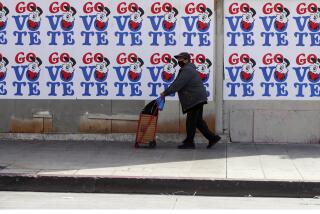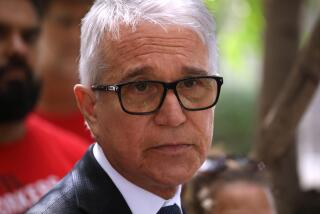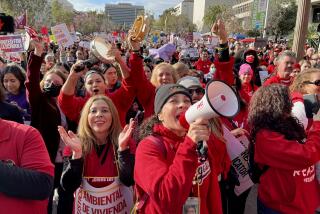Candidates. And more candidates
- Share via
That’s about 40 down and about 37 to go. Candidates, that is -- candidates for city, school board and community college offices in the March 3 Los Angeles election.
The Los Angeles Times editorial board this week hit about the halfway mark in interviewing candidates who are seeking its endorsement. Time is tight. With the November election right behind us, we began interviewing candidates in December, gave ourselves a three-day break after New Year’s Day, and then picked up the pace. One mayoral candidate didn’t get back to us until last week but, except for him, we’ve been through that race, as well as those for city attorney, controller and about half the City Council seats.
This week we’re meeting and vetting the 12 candidates for the 13th Council District; then it’s the 9th District, and then the school and college board seats.
VIDEO: Interviews with L.A.’s mayoral candidates
Board members are doing some deliberating along the way, but we haven’t yet made our decisions. That will come soon. We can’t really give ourselves until election day because, let’s face it, it’s half over by then; people begin voting by mail a month before. I don’t think we’ll be ready to endorse in all the races at the end of the first week in February, but soon thereafter.
Why does a newspaper endorse candidates in an election? It’s part of its function. Our colleagues on the news side report the news and keep their opinions out of it; but newspapers also have opinionators, and that’s what we on The Times’ editorial board are.
We read the news along with everybody else; we do our own reporting. We look, we listen, we assess, and we offer up our thoughts on what policies are best, what laws are best, what choices are best, and why.
We’d be dropping the ball if we didn’t also, at election time, hold ourselves to account for those decisions and do exactly what we ask voters to do -- choose candidates. And then we follow up, during the winners’ terms, to assess whether they perform as well as we had hoped.
Our readers, of course, will make up their own minds. We find that many of them do that in part by participating in real or virtual discussions with others, including us, who also think these things through and have opinions to express.
Sure, there are some people who say they rely on Times endorsements to make decisions on lesser-known races, such as Superior Court judge, and when those races are on the ballot (last year and next year, but not this year), we do our best to make the most solid recommendations and back them up with fact and argument. That’s how we work in all races for which we endorse.
There may be a few voters who claim to just do what we say, and there are most certainly voters who make a point of telling us, each election season, that they vote exactly the opposite of our recommendations.
OK, folks, either way, glad to be of service -- although we’re pretty sure that after all is said and done, those voters, just like the others, do their own thinking.
We try to be as transparent as possible about the choices we make and how and why we make them, but newspaper endorsement decisions are sometimes still a bit mysterious. One common misconception is that the editorial board is a board of Times editors.
Well, that’s a natural assumption, but no; the people who edit Times news stories, including the editor in chief, are not part of the editorial board and have no role in endorsement decisions.
The members of the editorial board neither work for nor report to the editor in chief. The news and opinion sides are completely separate. The board is a staff of seven editorial writers, and we report to three opinion-only writer-editors, who in turn report to the publisher. Our colleagues on the news side find out about our endorsement decisions the same way we find out about their news stories -- when they appear online or in print.
We don’t base our decisions solely on our meetings with each candidate. Someone can give a lousy interview and still be a great candidate, and vice versa. We report, by which we mean that we talk to people, go to candidate forums, discuss the city’s needs and shortcomings. We then try to decide which candidate would do the best job for the voters.
This election, we are meeting with each candidate who qualified for the ballot. How about the write-in candidates? We reserve the right to make an exception or two, but generally, no. The requirements and deadlines to qualify for the ballot are clear, and a candidate who can’t even gather the requisite number of valid signatures or turn them in on time has already, by definition, failed a most basic test.
So we’ve got a couple of weeks and about three dozen candidates to go. We’re perhaps getting a little less patient with empty slogans (“I intend to be a [fill in the office here] for ALL of Los Angeles!”), a little obsessive about breaking out the hand sanitizer after a round of hand-shaking (but really, it’s flu season, and the odds are that at least one of those 77 candidates is a carrier. Right?) and maybe a little twitchy whenever anyone mentions the word “runoff” (The next election: May 21. Heaven help us). But we’re listening. And learning.
ALSO:
L.A. imagined: The city that isn’t
Video interviews with mayoral candidates
More to Read
A cure for the common opinion
Get thought-provoking perspectives with our weekly newsletter.
You may occasionally receive promotional content from the Los Angeles Times.











